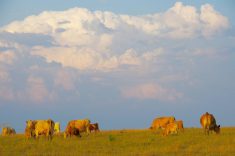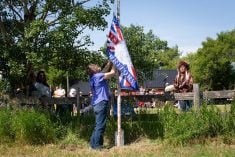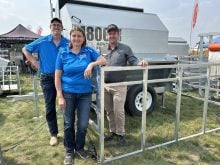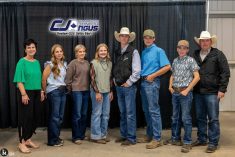For too many years I was like most of you. I thought profitable ranching started with the cattle. Truly profitable ranching starts with the soil, moves through the plants to feed the animals and then finally we manage the animals to provide a good profit. We will talk about soil and plants in later articles, but for now let’s discuss cattle.
What is a good cow?
Many years ago I heard a well-respected cattle producer tell an audience that,“instead of telling cattle what to look like, we should tell them what we expect them to do; and then let them look like whatever they need to look like in order to do what we want them to do.”
Read Also

Canadian Beef Check-Off Agency reports on investments and activities
The check-off agency’s work behind the scenes is what ensures cattle check-off dollars are invested wisely, accounted for transparently and deliver measurable value back to producers and importers.
That statement has stuck with me for many years, and I have become more convinced that he was right. If you cull cows when they don’t do what you expect them to do and only select bulls from cows that do what you expect them to do, over time you will have fewer and fewer culls and the cows seem to come to a common biological or phenotypic type. It may take some years, but it will happen. Learn to like the type they become.
So, what do I expect a cow to do?
- Calve unassisted every year in the first 25 days of the calving season. That means that she will breed in the first cycle of each breeding season.
- Be a very good and protective mother with an excellent udder.
- Raise an acceptable calf for my environment. (The calf doesn’t have to be fantastic or exceptional.)
- Never be doctored or handled except for routine immunizations for general herd health.
- Have good mobility — feet and legs.
- Not be wild or mean.
Naturally, we are all going to have cows in our herds that don’t meet all these criteria; but the ones that don’t should be on our prioritized cull (market) list and removed as soon as we can produce enough pregnant (first-cycle) replacements for them.
It is also these cows that get to be the mothers of bulls. The others have simply shown that, while okay, they aren’t good enough regardless of their EPDs or physical appearance. This method of picking mothers of bulls may eliminate a few good cows, but it gets rid of all of the inferior ones. Glenn Barlow of Gillette, Wyo., puts a few bulls with two-year-old heifers when they start to calve to discover the true calving interval between the first and second calf. He considers this calving interval to be the best indicator of female fertility.
Now we can talk about the biological or phenotypic type. I think we all use some visual measures to help us manage the herd or even judge or rank the cattle. We want cattle that maintain a good body condition score (BCS), shed off early in the spring, have good mobility, good health, good eyes and are somewhat insect and pest resistant, etc. Once in a while a tall, narrow (not thick), rough-haired cow with a fly load and a BCS 4 will get pregnant and raise a pretty good calf (surprise), and you will ask, “Why (how) did this cow get pregnant when that ‘good one’ didn’t?”
I might ask, “Which one is the ‘good one?’” I think we should use these biological-type indicators as secondary culling criteria, but remember if she “does” or “doesn’t” is more important. That’s where the dollars flow.
Some people will tell me that they might keep the “surprise” cow described above, but they aren’t going to keep her heifer calf. To that, I will ask, “Aren’t you using good bulls?” You know their answer. None of us are using poor bulls — or are we? Then why not sell the cow or, at least, keep the heifer calf? If the sire is good, there should be a high probability that the calf will be better than her dam that wasn’t all bad — just ugly, but she bred on time every year and produced an okay calf.
Again, if you select cows as described here, over time they will look more and more alike and come to the size and type that fits your environment and management. The key is to avoid using bulls that will “undo” what you are trying to do with your culling.
What is a good bull?
A good bull is born to a cow like those just described. In addition, at one year of age he has a good ratio of weight to hip height when compared to his contemporaries. Johann Zietsman describes this as “eight in five” or like visualizing eight lbs. of sugar in a five-lb. bag — certainly not three in five. The yearling bull also shows evidence of testosterone and masculinity — starts to look like a bull. Then when used at a year of age with same age contemporaries in the same herd, he sires more calves than they do. Mr. Barlow, mentioned above, puts yearling bulls (only yearlings) with his yearling heifers — one bull for every 10 heifers. Then at calving he uses DNA to define the sire and know how many pregnancies each bull produced as a yearling.
So, there you have it: 1) born to an exceptional cow, 2) at an age that has very good weight in relationship to height, and 3) sires more calves than contemporaries when all are given the same opportunity. Do you know if your bulls have been selected by these criteria?
If you need to produce 10 bulls per year, you might want to start with at least 50 cows from which you could get 20 to 25 bull calves. You will want to have a good number from which to select 10 bulls at a year of age. If you run those 10 with one set of cows or heifers, and track how many calves each sires, you will again reduce the number to somewhere between five and seven. Using good selection pressure, will improve the rate of progress in your cow herd.
If you are a commercial producer trying to produce some or all of your own bulls, you can’t just look at the calves in the branding pen and pick out the six or seven that you think you will ultimately need. It’s very difficult at that age to pick out the good ones. Maybe you kept track of the bull’s mother but maybe not. You don’t know what the weight/height ratio will be when compared to others at a year of age; nor do you know how many calves he will sire as a yearling.
The economics lesson
Please understand that, while weaning weights are important, they do not need to be huge. It is easy to push genetics beyond what your environment is capable of supporting. Increasing weaning weights beyond the natural fit for your environment will always cost money. It could be directly in the cost of additional inputs or indirectly in the cost of maintaining a bigger, less fertile cow. You run fewer of those bigger cows on the same acres and produce fewer pounds of weaning weight per acre.
Burke Teichert is a long-time manager of large ranches. He is also a consultant and speaker. Contact him at [email protected]
















